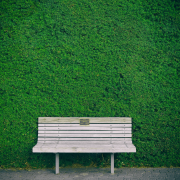My garden transformation project (Progress update: month one to three)
I’m three months into my year-long project to transform my garden from lawn {sobs… so much lawn!} into the beginnings of an urban food forest – veggie beds and fruit trees. And I thought it was time for an update – and some progress shots.
Let me tell you, I hate in-progress shots! That time when it’s obvious you’ve done ‘something’, but it all looks patchy and half-baked and nothing the vision that’s in your head.
That’s the stage I’m at right now.
But it’s good to document progress nonetheless, and hopefully there will be a time when there are ‘after’ shots that look at least vaguely like my vision!
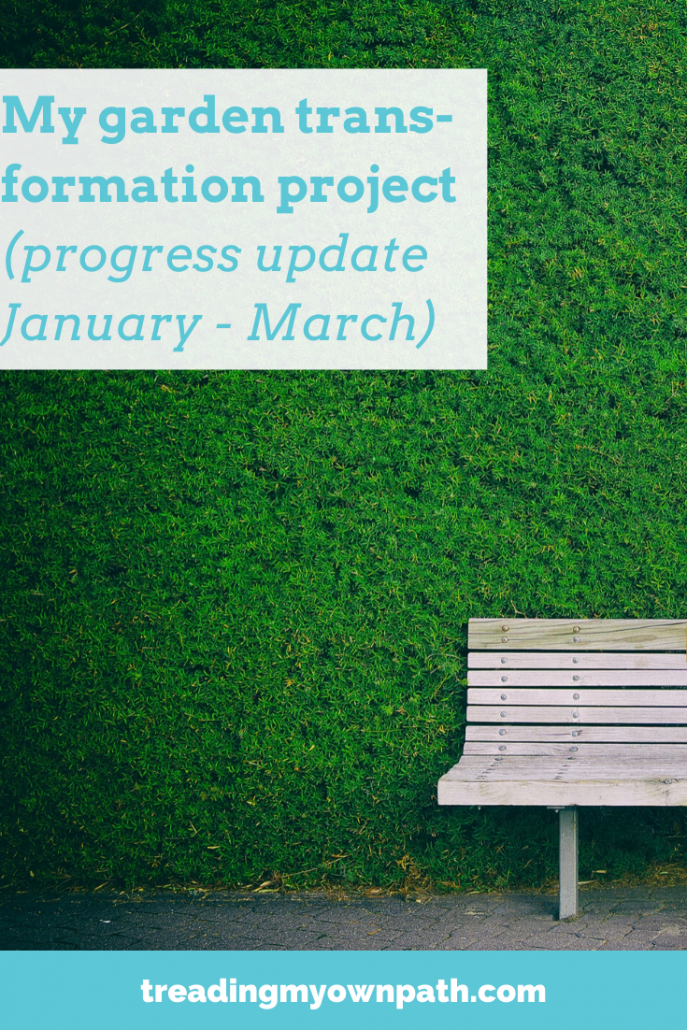
The garden transformation project: from lawn to food forest
The first thing I did was make a rough plan of the different ‘zones’ in the garden. I’ll talk more about how to do this in a separate post, but in simple terms, it means thinking about a few things.
First, the different uses. There are the uses/functions that I want: do I want lawn? Patio? Veggie beds? A chicken run? Fruit trees? A pond? A space for the dog? etc etc.
Then there are the different microclimates within my boundary – which affect which things will work successfully in those spaces, and which won’t work.
Even though my block is pretty small, there is still a spot that gets beaten by the afternoon sun, several spaces that won’t get any sun in winter because of the shade patterns, a cooler side area with little light that is more suitable for trees (because they can grow up to the light).
There’s also what’s going on outside my block to consider. The neighbours’ buildings and trees (which provide shade – which may or may not be a good thing, depending on where they are); trees also have roots that do not understand boundaries and like to get into unsuspecting garden beds.
And then there are the limiting factors of the climate. In Perth, the sun (and heat) is a limiting factor; water is another. And water alone isn’t enough to keep plants alive on blistering 40°C+ days in full sun. Shade is important, too. Then there is the fact that certain plants just won’t grow (and others will do fantastically well) where I live.
I can want a coconut palm tree with all my heart, but I just don’t have the right climate (not wet enough and winters are much too cold) to grow one to fruit.
So with all these things in mind, I have a few different zones:
- The front verge – natives/edible natives (the verge is connected to my front garden but the land is owned by the council, not me. They encourage the planting of native gardens (which are waterwise) on verges.
- The front garden (north facing) – I’d like to put in-ground veggie beds here, but there is a huge tree at the front and I need to figure out if there will be enough sun in winter.
- The side strip (east of house) – deciduous fruit trees. There is a raised bed along the side so they have a bit of extra height to get to the sun, which they will need to set fruit. In winter when the sun is lower, deciduous fruit trees are dormant, so that works.
- The back garden (southern end, at the back) – this is where I’m putting the hardiest and tropical plants. They will get sun all year, and will be battered by the summer afternoon sun, so it makes sense to choose the hardiest trees for here. The plan is that as they grow bigger they will provide shade from the afternoon sun for the smaller and more sensitive trees and other plants.
- The back garden (in the middle, eastern side) – I’m planning to put citrus trees here. They will still get sun in winter.
- The back garden (in the middle – western side) – I’m keeping some lawn. For now. They say relationships are about compromise, and here is how I compromise…
- The back garden (furthest north, nearest the house) – deciduous trees. This spot won’t get a lot of sun in winter, which makes it perfect for deciduous trees.
(I’ll write a post sometime about planning for fruit trees, because there are a few things to know if you’re going to grow them successfully.)
These are the before photos from when I moved in (well technically from the real estate agent, hence the wide angle lens and bright colours, and taken in August when the rain is plentiful).
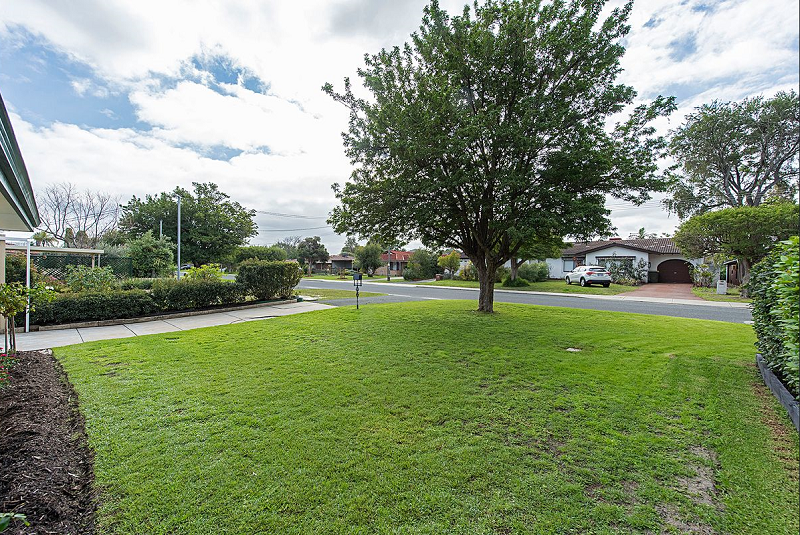
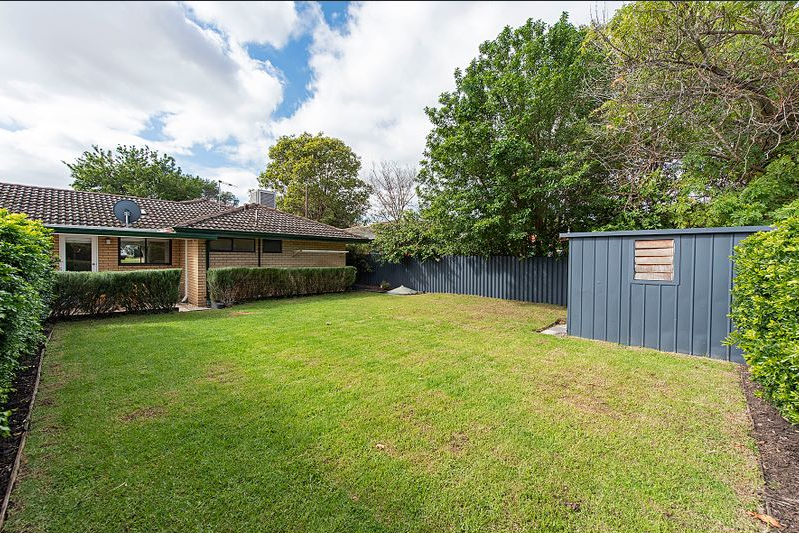
I’ve already written about my first steps: getting the compost cranking, and getting chickens. I also had a change of plans when I decided in March to put in some vegetable beds (something I was going to wait until later in the year – possibly September – to do).
My other priorities over the past three months have been:
- Digging up the lawn and mulching to bring some life back into the soil;
- Mulching the dead area down the side of the house, to get the soil semi-ready for fruit trees;
- Starting to plant trees in other spots around the garden;
- Getting quotes to sort out the reticulation;
- Beginning a verge plan to submit to the council (they offer a rebate).
Digging out the lawn (front garden)
In Perth, it’s too hot to have exposed soil. The sun just kills all life. The answer is mulch. Coarse street tree prunings are ideal – they are also affordable, and sometimes even free.
After being on the waiting list at mulchnet since the October weekend I moved in, I got lucky in January. A free truckload of mulch.
Some might say, perhaps too lucky…?
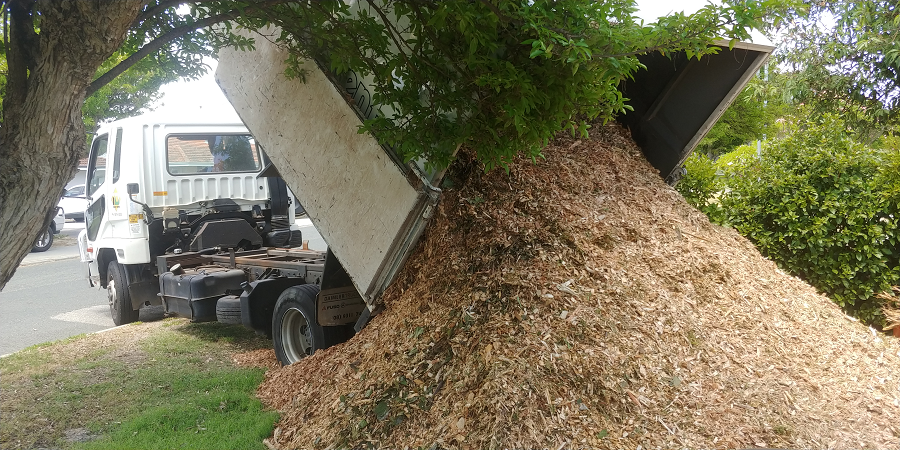
I’d already started digging up the lawn at the front before this arrived – I’d shovelled four trailerloads of mulch from a friend’s place (which involved borrowing a trailer from Buy Nothing and utilising her trailer towing skills).
But now I have enough mulch for a lifetime.
In the photo below, the pile on the right is the four trailerloads, and the pile on the left is my lifetime supply. You can see the turf I’ve dug out waiting for the green waste collection on the verge (they happen four times a year).
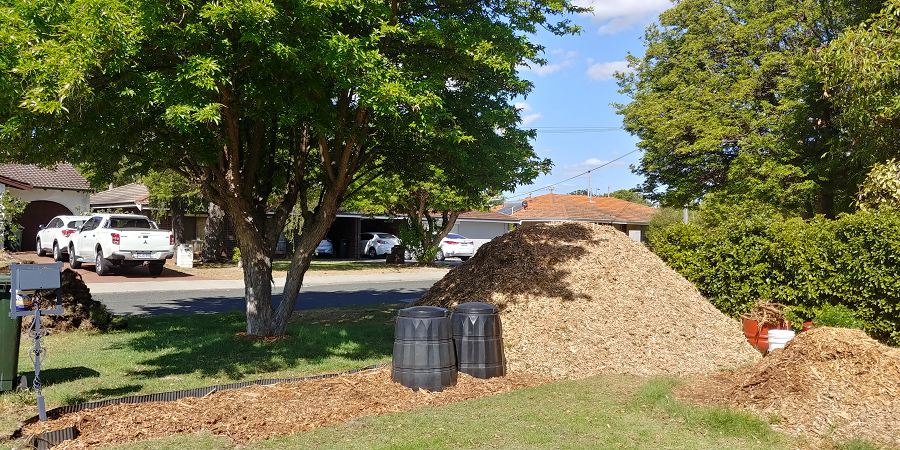
Eventually you won’t be able to see most of the mulch covering the ground for plants, but they need to be planted in late autumn / winter / early spring when they have more chance of establishing roots and surviving.
It will also take a few years to get the plants properly established.
Digging out the lawn (back garden)
I planted a banana tree in my ‘tropical’ zone at the end of December – my first tree. It’s next to the (metal) shed to provide shelter and reflect some warmth (radiated heat) in winter.
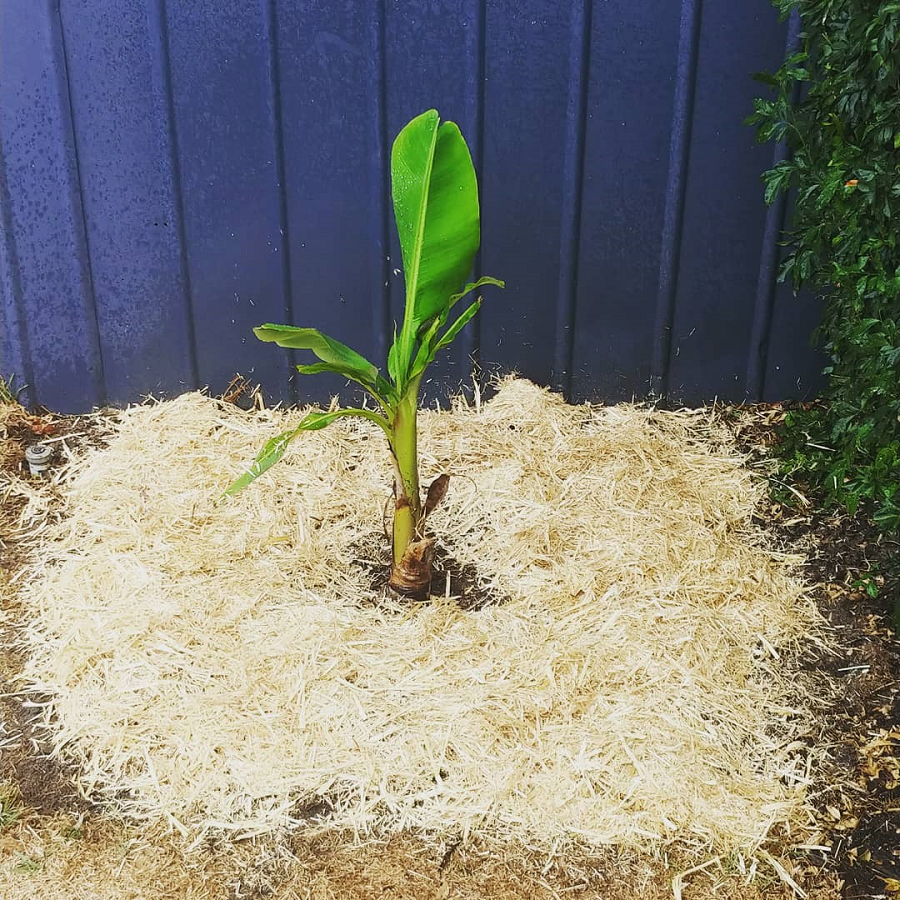
From this spot I began to dig out more lawn. (It was a particularly straggly and patchy spot.) I’ve added a papaya and four pineapples.
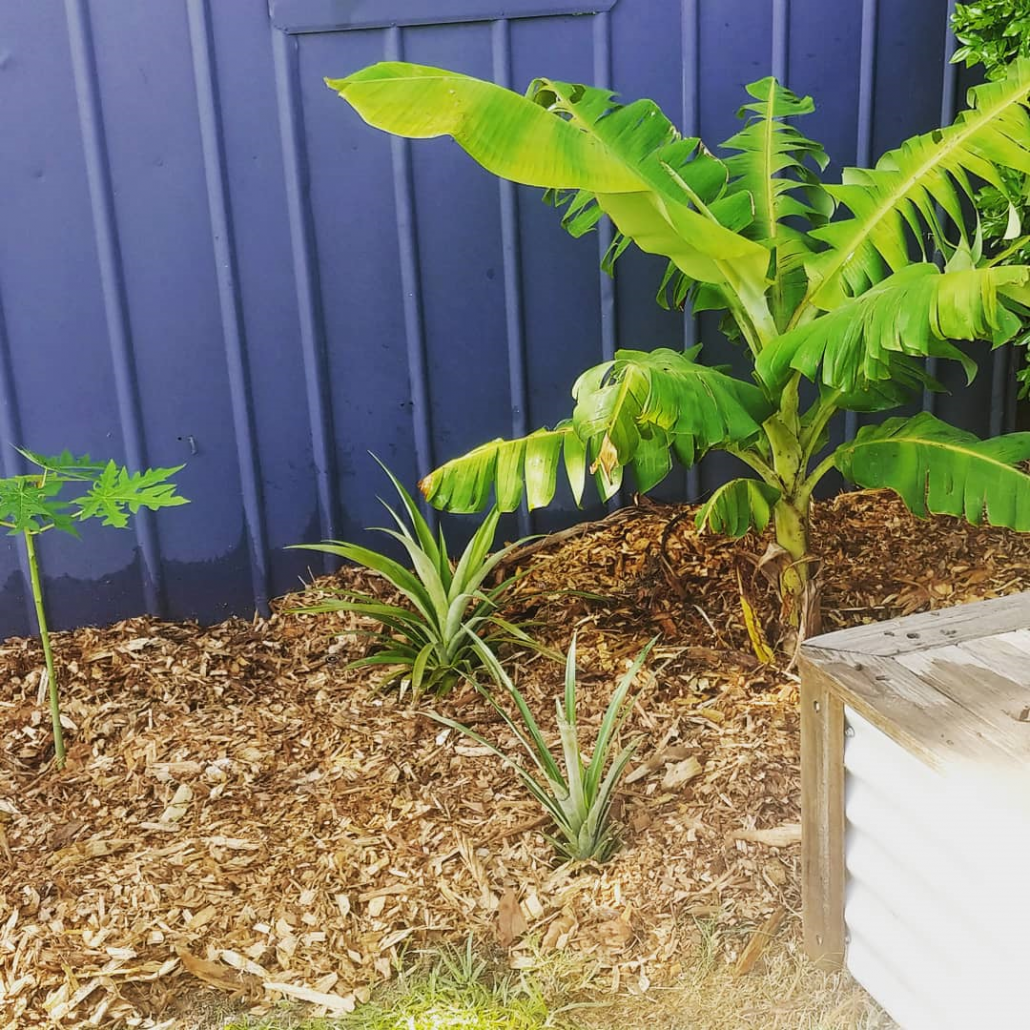
Elsewhere, I also planted two more trees – a dwarf mulberry (grafted) and a fig, closer to the house. These go dormant in winter and I wanted to get them in the ground now to establish some roots first.
I’ll never forget being told this at a fruit tree workshop several years ago: never plant a one hundred dollar tree in a five dollar hole. The point being, invest in the soil more than the tree. Now my mulberry wasn’t $100 (it was $25) and the fig was a freebie grown from a cutting, but I still heed to that rule.
With the soil I have, it needs all the help I can give it.
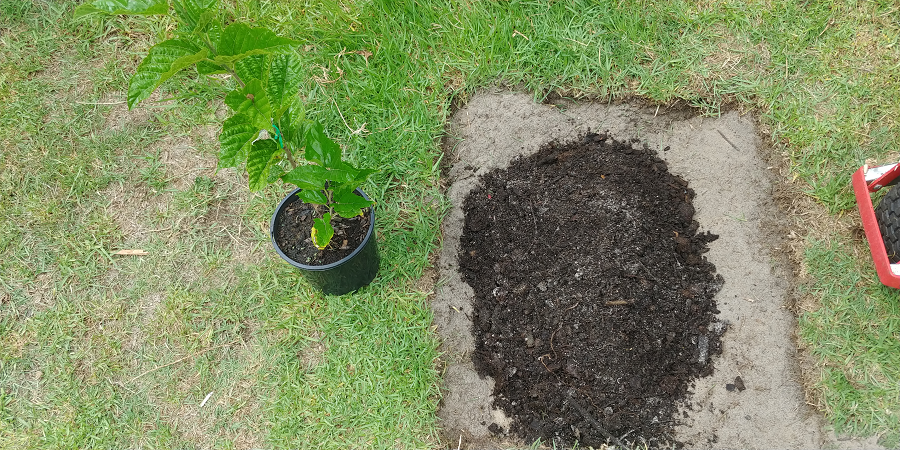
That sand next to my mulberry tree is my base soil. Digging out a heap of that ‘soil’ to replace with compost, aged manure, seaweed, clay and a bit of biochar (scored from the side of the road) took a few hours.
But the effort, and investment in amendments like these, is worth it in the long run.
Figs are notorious for having spreading roots, but they actually grow very well with restricted roots. Pots are good but here, they dry out quickly. So I tried something I saw on the interwebs – planing in a washing machine drum.
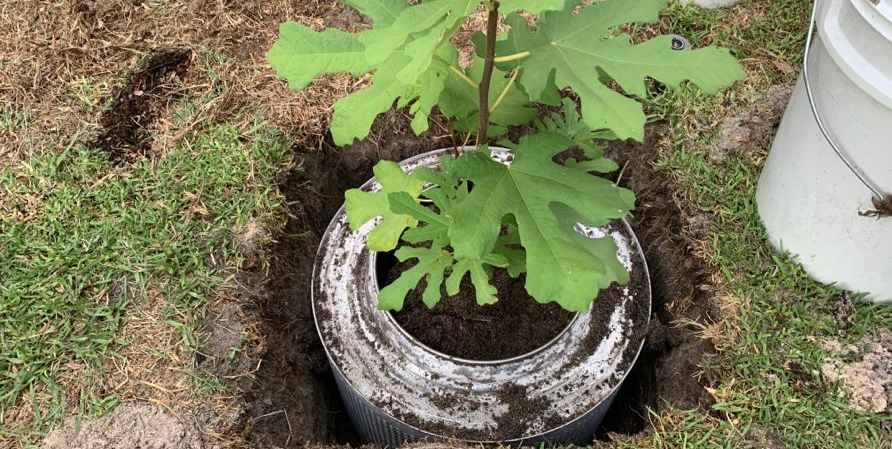
This is one of those in-progress shots that I hate, where the trees look so small and weedy. The grass between and behind them will eventually be removed – there’s just only so much grass that can be dug out per week!
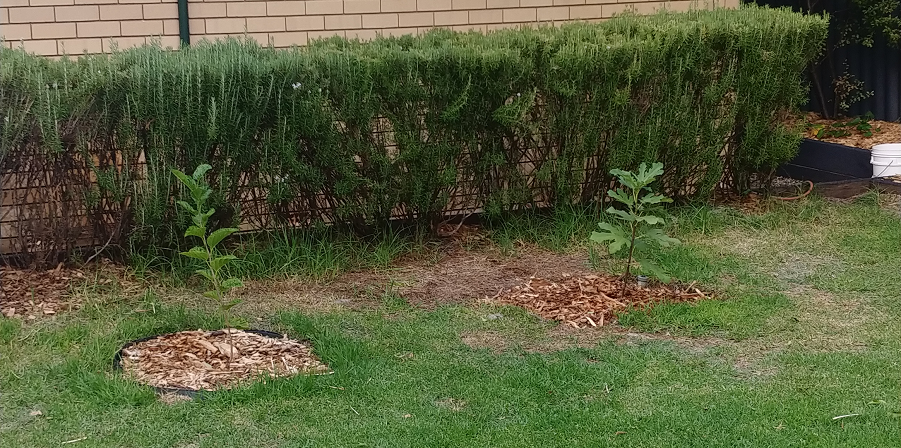
They are both fast growing trees, however, and they’ve already started to look a little less pathetic, and have reached the height of the hedge.
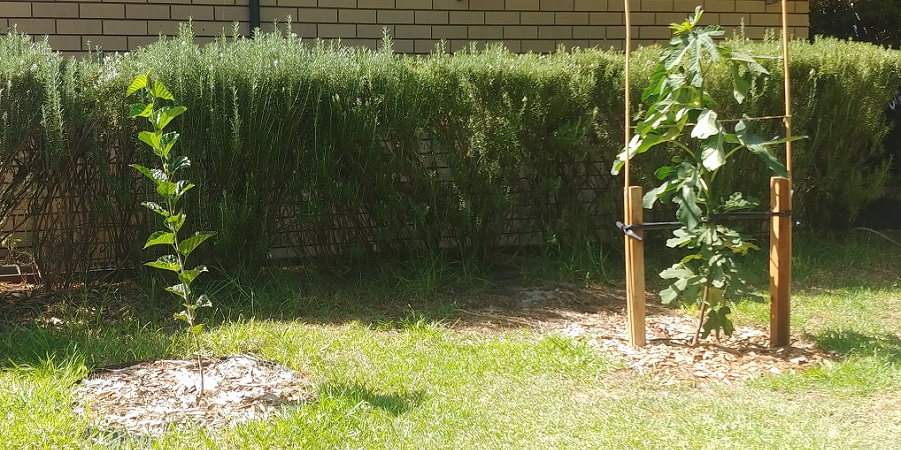
Growing vegetables
During summer, I’d planted out a small garden bed with tomato plants. It was positioned in its original spot to get the morning sun and afternoon shade (but no winter sun). Sadly, rats got almost all of the tomatoes (and the cayenne chillies I planted in the adjacent orange tub, disappointingly).
The whole area looks weedy and bedraggled. I decided to move the bed to a better spot for winter, and away from the hedge. (I also have a medium term plan of planting a macadamia tree where the bed is – to provide afternoon shade in summer to the rest of the garden.)
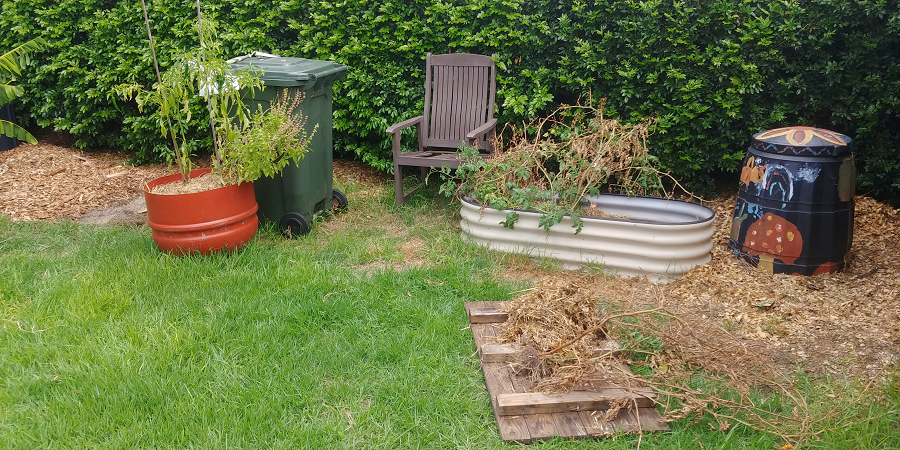
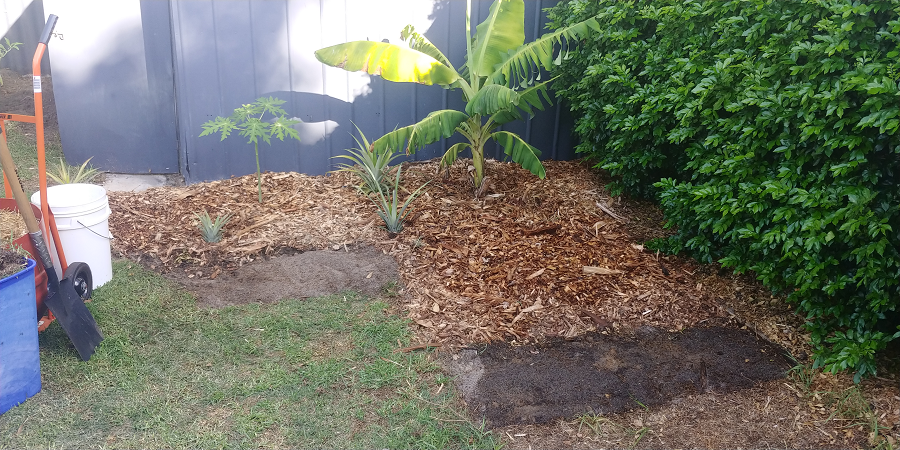
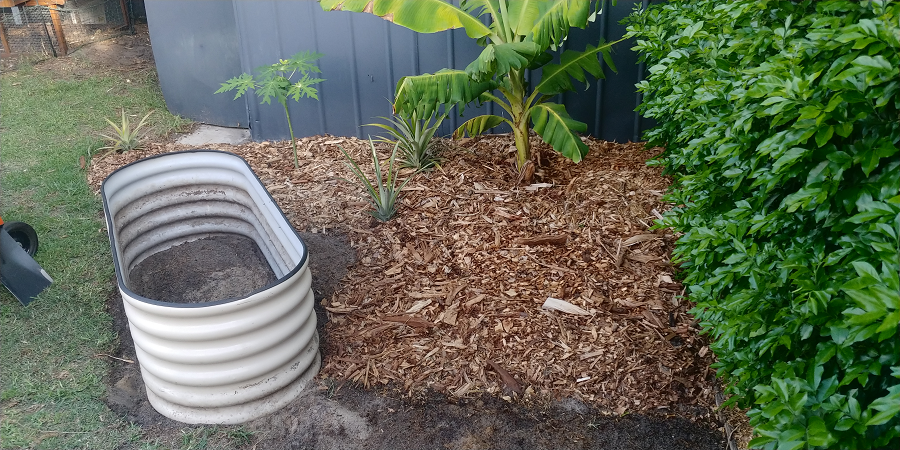
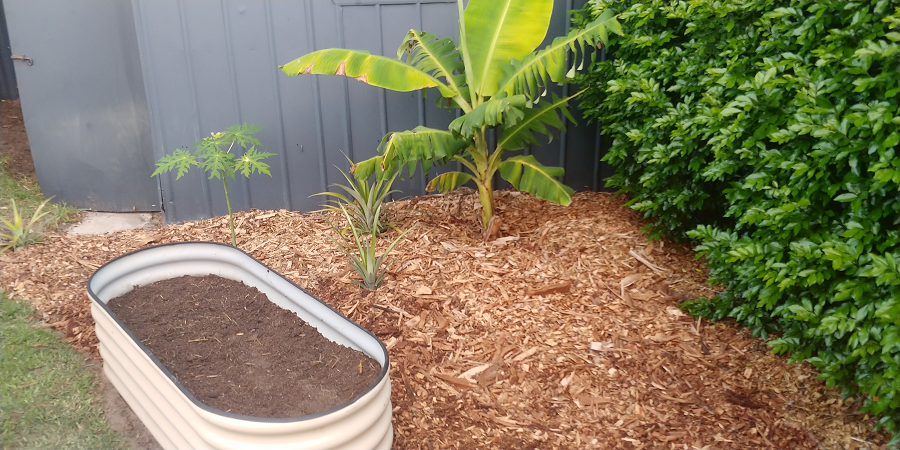
This is where the plan deviated slightly. I’d just finished digging in this bed (22nd March, my photos are date stamped so I can be sure!) when all of the coronavirus changes were starting to happen – food shortages, store restrictions, vegetable seedlings and seeds selling out, and potential lockdown.
And so I panic purchased two big garden beds to get started growing vegetables now. I went with raised beds because a) I have a dog that doesn’t like heights so won’t climb in them b) they were the quickest thing to get going c) if I want to move them later on, they are actually very lightweight d) there is a good second-hand market for them, so I can sell later if I change my mind. Oh and e) they match the one I already have.
I ordered them on the Monday, expected them to be delivered by the weekend, and they came the next day.
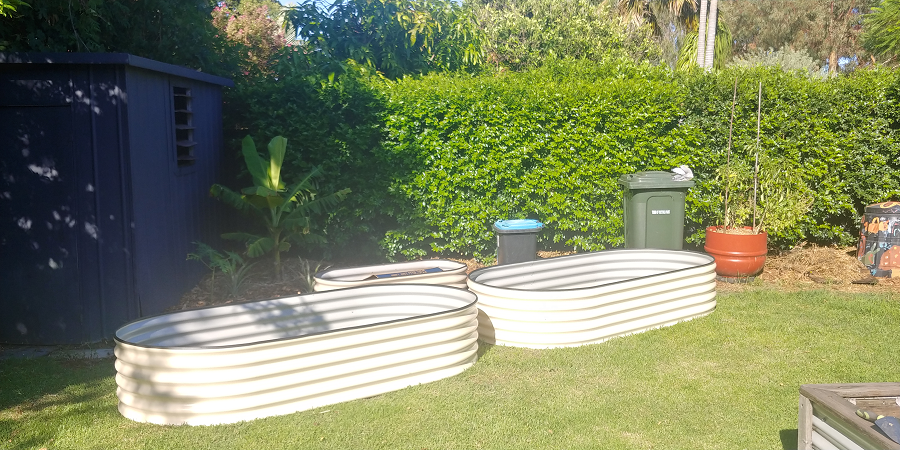
I spend that weekend digging out the lawn, had a soil delivery the following Monday and got the first bed ready that day. It took me until the end of the second weekend to finish the second one.
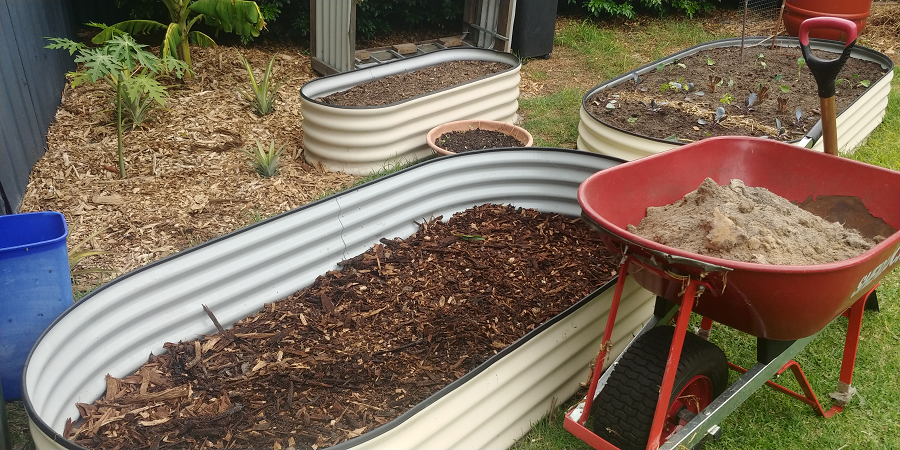
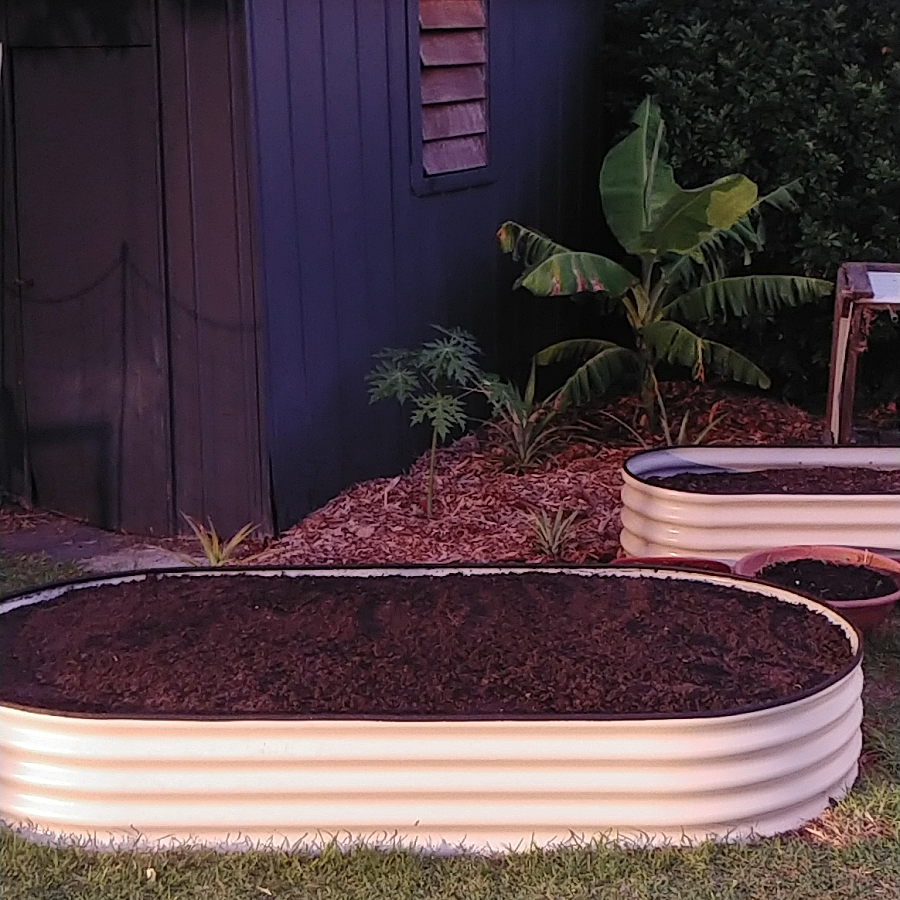
I’ve planted the beds out with seedlings, garlic and seeds from my stash that are mostly expired – so we will see if any germinate. So far I’ve had luck with radish and not much else, but it is early days.
Garden plans: what’s next?
It’s still very much on my to-do list to get the reticulation sorted, particularly as I’m beginning to plant more things out and don’t to damage any roots putting it in later.
The next priority is planting trees. I’ve purchased a few (including the macadamia I mentioned earlier) and I have a few grown from seed.
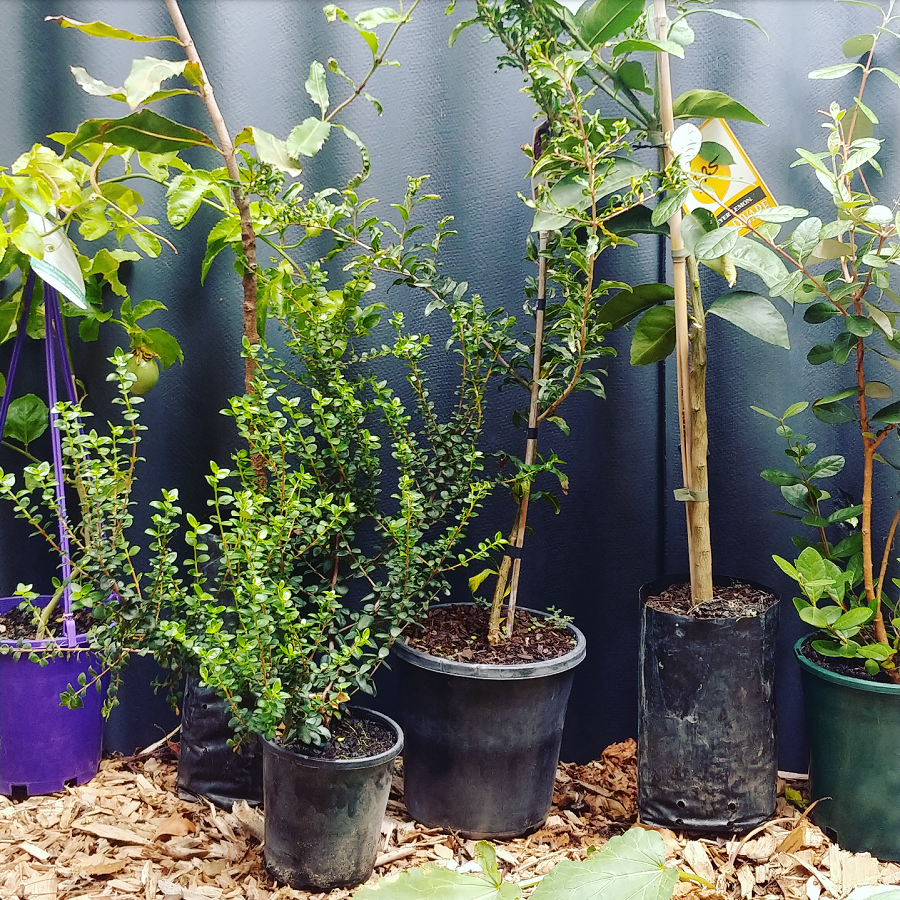
I’d normally have waited a couple more months before purchasing, when the weather is cooler, but I was worried they might lock down the tree place, so I made my move early. Now it’s important to get them in the ground.
Oh, and the other priority – digging out more lawn. Sigh.
Now I’d love to hear from you! Any garden questions, send them my way! Any comments, send them my way too! And any other thoughts you have, about growing vegetables or fruit trees, planning a garden, or anything else – share them all. Just leave a note below :)

